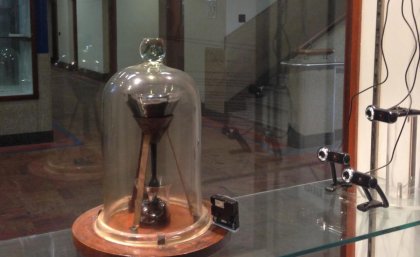
As Cyclone Ita hit northern Australia last weekend, a much slower collision occurred in the world’s longest-running lab project, The University of Queensland’s Pitch Drop Experiment.
After a wait of more than 13 years, the ninth drop of pitch collided ever so slowly with the eighth drop in the bottom of the beaker.
The experiment was set up in 1927 to demonstrate that solid materials — pitch shatters if hit with a hammer — can flow like liquids.
Pitch Drop custodian Professor Andrew White said seven drops had fallen between 1930, when the experiment began, and 1988, at an average of one drop every eight years.
“Two things changed after that – the 2000 (eighth) and 2014 (ninth) drop each took about 13 years to fall, and each collided into the decades-old pile of drops in the beaker before it could break away from the funnel,” he said.
The eighth drop ran into the seventh drop in 2000, but took almost 14 years to tip over.
“It was still connected to the ninth drop but almost broke free this year.
“The connection had become thin, stressed and light grey – but now that the ninth drop has run into it the whole cycle starts again,” Professor White said.
The stealthy collision is the latest trick by this evasive lump of tar. Until now, no-one has ever seen a drop fall.
The former custodian of the experiment, the late Professor John Mainstone, missed observing the drops fall on three occasions – by a day in 1977, by only five minutes in 1988 when it was on display at the World Expo in Brisbane, and in 2000 when a webcam that was recording it missed the crucial moment when the drop fell during a 20-minute power outage.
The experiment was subsequently put under constant surveillance, with three webcams trained on it to capture the ninth drop’s fall.
Nearly 25,000 viewers from 158 countries have registered to keep an eye on the ninth drop through the live web stream at www.theninthwatch.com.
Those who were watching when it collided will have their names recorded for posterity.
“To determine the actual moment, we’re going to analyse the video to see if and when the pitch motion slowed down, and hopefully we can let people know soon,” Professor White said.
“We look forward to observing what will happen next with the ninth drop.
“It may tip over quickly or it might slow right down and take years to break away from the imminent tenth drop,” he said.
Media: Professor Andrew White +617 466 256 329, agx.white@gmail.com; UQ Faculty of Science Engagement Manager Julie Baglot, +617 411 162 577, j.baglot@uq.edu.au; Engagement Officer Aarti Kapoor, +617 449 863 208, a.kapoor@uq.edu.au
Visuals:
- UQ Pitch Drop Time Lapse Video – April 2012 to April 2014
- Final Hours Before Ninth Drop - 9 April 2014 to 14 April 2014
.jpg)











